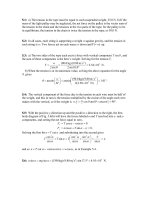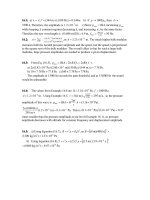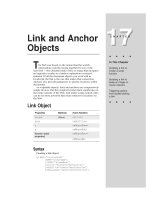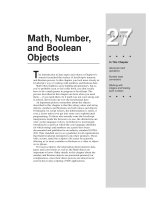Tài liệu Javascript bible_ Chapter 27 ppt
Bạn đang xem bản rút gọn của tài liệu. Xem và tải ngay bản đầy đủ của tài liệu tại đây (80.64 KB, 12 trang )
Math, Number,
and Boolean
Objects
T
he introduction to data types and values in Chapter 6’s
tutorial scratched the surface of JavaScript’s numeric
and Boolean powers. In this chapter, you look more closely at
JavaScript’s way of working with numbers and Boolean data.
Math often frightens away budding programmers, but as
you’ve probably seen so far in this book, you don’t really
have to be a math genius to program in JavaScript. The
powers described in this chapter are here when you need
them — if you need them. So if math was not your strong suit
in school, don’t freak out over the terminology here.
An important point to remember about the objects
described in this chapter is that like string values and string
objects, numbers and Booleans are both values and objects.
Fortunately for script writers, the differentiation is rarely, if
ever, a factor unless you get into some very sophisticated
programming. To those who actually write the JavaScript
interpreters inside the browsers we use, the distinctions are
vital. As the language evolves, its behavior is increasingly
formalized to a point at which the core language attributes
(of which strings and numbers are a part) have been
documented and published as an industry standard (ECMA-
262). That standard serves as a guideline for all organizations
that build JavaScript interpreters into their products. These
folks, in turn, make the scripter’s life easier by generally
allowing us to treat a number or Boolean as a value or object
as we please.
For most scripters, the information about numeric data
types and conversions as well as the Math object are
important to know. Other details in this chapter about the
number and Boolean objects are presented primarily for
completeness, since their direct powers are almost never
used in day-to-day scripting of Web applications.
27
27
CHAPTER
✦ ✦ ✦ ✦
In This Chapter
Advanced math
operations
Number base
conversions
Working with
integers and floating-
point numbers
✦ ✦ ✦ ✦
568
Part III ✦ JavaScript Object and Language Reference
Numbers in JavaScript
More powerful programming languages have many different kinds of numbers,
each related to the amount of memory they occupy in the computer. Managing all
these different types may be fun for some, but it gets in the way of quick scripting.
A JavaScript number has only two possibilities. It can be an integer or a floating-
point value. An
integer is any whole number within a humongous range that does
not have any fractional part. Integers never contain a decimal point in their
representation. Floating-point numbers in JavaScript spread across the same range,
but they are represented with a decimal point and some fractional value. If you are
an experienced programmer, refer to the discussion about the number object later
in this chapter to see how the JavaScript number type lines up with numeric data
types you use in other programming environments.
Integers and floating-point numbers
Deep inside a computer, the microprocessor has an easier time performing math
on integer values as compared to any number with a decimal value tacked on it,
which requires the microprocessor to go through extra work to add even two such
floating-point numbers. We, as scripters, are unfortunately saddled with this
historical baggage and must therefore be conscious of the type of number used in
certain calculations.
Most internal values generated by JavaScript, such as index values and length
properties, consist of integers. Floating-point numbers usually come into play as
the result of the division of numeric values, special values such as pi, and human-
entered values such as dollars and cents. Fortunately, JavaScript is forgiving if you
try to perform math operations on mixed numeric data types. Notice how the
following examples resolve to the appropriate data type:
3 + 4 = 7 // integer result
3 + 4.1 = 7.1 // floating-point result
3.9 + 4.1 = 8 // integer result
Of the three examples, perhaps only the last result may be unexpected. When
two floating-point numbers yield a whole number, the result is rendered as an
integer.
When dealing with floating-point numbers, be aware that not all browser
versions return the precise same value down to the last digit to the right of the
decimal. For example, the following listing shows the result of 8/9 as calculated by
numerous scriptable browsers (all Windows 95) and converted for string display:
Navigator 2 0.88888888888888884
Navigator 3 .8888888888888888
Navigator 4 .8888888888888888
Internet Explorer 3 0.888888888888889
Internet Explorer 4 0.8888888888888888
569
Chapter 27 ✦ Math, Number, and Boolean Objects
It is clear from this display that you don’t want to use floating-point math in
JavaScript browsers to plan spaceflight trajectories. But it also means that for
everyday math, you need to be cognizant of floating-point errors that accrue in PC
arithmetic.
In Navigator, JavaScript relies on the operating system’s floating-point math for
its own math. Operating systems that offer accuracy to as many places to the right
of the decimal as JavaScript displays are exceedingly rare. As you can detect from
the preceding table, the more modern versions of browsers from Netscape and
Microsoft are in agreement about how many digits to display and how to perform
internal rounding for this display. That’s good for the math, but not particularly
helpful when you need to display numbers in a specific format.
JavaScript does not currently offer any built-in facilities for formatting the
results of floating-point arithmetic. Listing 27-1 demonstrates a generic formatting
routine for positive values, plus a specific call that turns a value into a dollar value.
Remove the comments, and the routine is fairly compact.
Listing 27-1: A Generic Number Formatting Routine
<HTML>
<HEAD>
<TITLE>Number Formatting</TITLE>
<SCRIPT LANGUAGE="JavaScript">
// generic positive number decimal formatting function
function format (expr, decplaces) {
// raise incoming value by power of 10 times the
// number of decimal places; round to an integer; convert to
string
var str = "" + Math.round (eval(expr) * Math.pow(10,decplaces))
// pad small value strings with zeros to the left of rounded
number
while (str.length <= decplaces) {
str = "0" + str
}
// establish location of decimal point
var decpoint = str.length - decplaces
// assemble final result from: (a) the string up to the position of
// the decimal point; (b) the decimal point; and (c) the balance
// of the string. Return finished product.
return str.substring(0,decpoint) + "." +
str.substring(decpoint,str.length);
}
// turn incoming expression into a dollar value
function dollarize (expr) {
return "$" + format(expr,2)
}
</SCRIPT>
</HEAD>
<BODY>
<H1>How to Make Money</H1>
<FORM>
(continued)
570
Part III ✦ JavaScript Object and Language Reference
Listing 27-1 (continued)
Enter a positive floating point value or arithmetic expression to be
converted to a currency format:<P>
<INPUT TYPE="text" NAME="entry" VALUE="1/3">
<INPUT TYPE="button" VALUE=">Dollars and Cents>"
onClick="this.form.result.value=dollarize(this.form.entry.value)">
<INPUT TYPE="text" NAME="result">
</FORM>
</BODY>
</HTML>
This routine may seem like a great deal of work, but it’s essential if your script
relies on floating-point values and specific formatting.
Floating-point numbers can also be entered with exponents. An exponent is
signified by the letter “e” (upper- or lowercase), followed by a sign (
+
or
-
) and the
exponent value. Here are examples of floating-point values expressed as exponents:
1e6 // 1,000,000 (the “+” symbol is optional on positive exponents)
1e-4 // 0.0001 (plus some error further to the right of the decimal)
-4e-3 // -0.004
For values between 1e-5 and 1e15, JavaScript renders numbers without
exponents. All other values outside these bounds come back with exponential
notation.
Hexadecimal and octal integers
JavaScript allows you to work with values in decimal (base-10), hexadecimal
( base-16), and octal ( base-8) formats. You only have a few rules to follow when
dealing with any of these values.
Decimal values cannot begin with a leading 0. Therefore, if your page asks users
to enter decimal values that may begin with a 0, your script must strip those
zeroes from the input string or use the number parsing global functions (described
in the next section) before performing any math on the values.
Hexadecimal integer values are expressed with a leading “0x” or “0X”. That’s a
zero, not the letter “o”. The A through F values can appear in upper- or lowercase,
as you prefer. Here are some hex values:
0X2B
0X1a
0xcc
Don’t confuse the hex values used in arithmetic with the hexadecimal values
used in color property specifications for Web documents. Those values are
expressed in a special hexadecimal triplet format, which begins with a crosshatch
symbol followed by the three hex values bunched together (such as #c0c0c0).
Octal values are represented by a leading 0 followed by any digits between 0
and 7. Octal values consist only of integers.
571
Chapter 27 ✦ Math, Number, and Boolean Objects
You are free to mix and match base values in arithmetic expressions, but
JavaScript renders all results in decimal form. For conversions to other number
bases, you have to use a user-defined function in your script. Listing 27-2, for
example, is a function that converts any decimal value from 0 to 255 into a
JavaScript hexadecimal value.
Listing 27-2: Decimal-to-Hexadecimal Converter Function
function toHex(dec) {
hexChars = "0123456789ABCDEF"
if (dec > 255) {
return null
}
var i = dec % 16
var j = (dec - i) / 16
result = "0X"
result += hexChars.charAt(j)
result += hexChars.charAt(i)
return result
}
The
toHex()
conversion function assumes that the value passed to the function
is a decimal integer.
Converting strings to numbers
What has been missing so far from this discussion is a way to convert a number
represented as a string to a number with which the JavaScript arithmetic
operators can work. Before you get too concerned about this, be aware that most
JavaScript operators and math methods gladly accept string representations of
numbers and handle them without complaint. You will run into the data type
incompatibilities most frequently when you are trying to accomplish addition with
the
+
operator, but a string representation gets in the way. Also be aware that if
you are performing math operations on values extracted from form text boxes,
those object value properties are strings. Therefore, in many cases, those values
need to be converted to values of the number type for math operations.
Conversion to numbers requires one of two JavaScript functions:
parseInt(
string
[,
radix
])
parseFloat(
string
[,
radix
])
These functions were inspired by the Java language and are used here for
compatibility reasons. The term parsing has many implied meanings in
programming. One meaning is the same as extracting. The
parseInt()
function
returns whatever integer value it can extract from the string passed to it; the
parseFloat()
function returns the floating-point number that can be extracted
from the string. Here are some examples and their resulting values:
parseInt(“42”) // result = 42
parseInt(“42.33”) // result = 42









